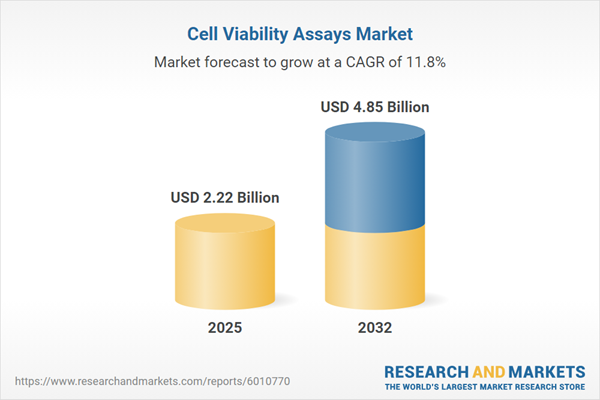Speak directly to the analyst to clarify any post sales queries you may have.
As the healthcare and life sciences sectors push the boundaries of cellular research, the cell viability assays market is evolving rapidly to meet the rising demands for precision and integration in drug discovery, clinical diagnostics, and biomedical research.
Market Snapshot: Cell Viability Assays Market Growth
The cell viability assays market grew from USD 1.99 billion in 2024 to USD 2.22 billion in 2025 and is expected to reach USD 4.85 billion by 2032, posting a CAGR of 11.76%. Robust growth reflects increasing demand for integrated, high-throughput screening technologies and the pivotal role of viability testing in accelerating new therapy development. Adoption is strong across academic, pharmaceutical, and contract research settings, supporting advancements in precision medicine and toxicity profiling.
Scope & Segmentation
- Product Types: Assay kits (colorimetric, fluorometric, luminescent), instruments, software
- Detection Methods: Chemiluminescent, colorimetric, fluorometric (Calcein AM, Resazurin), luminescent (ATP, Luciferase)
- End Users: Academic and research institutions, contract research organizations, hospitals and diagnostic centers, pharmaceutical and biotechnology companies
- Applications: Basic research, cell proliferation studies, cytotoxicity testing, drug screening
- Regions Covered: Americas (North America, Latin America), Europe, Middle East & Africa, Asia-Pacific
- Leading Companies: Thermo Fisher Scientific Inc., Merck KGaA, Bio-Rad Laboratories, Inc., Promega Corporation, PerkinElmer, Inc., Agilent Technologies, Inc., Danaher Corporation, Becton, Dickinson and Company, Corning Incorporated, Lonza Group AG
Key Takeaways for Senior Decision-Makers
- Technological progress in assay chemistry, detection systems, and automation is elevating data quality and operational efficiency for cell viability assessments.
- Platform interoperability and integration with high-content imaging and advanced analytics are now critical to support scalable and reproducible workflows in research and clinical settings.
- Market segmentation reveals diverse user needs: academia values flexibility, pharma demands throughput, diagnostics require rapid results, and CROs prioritize both scalability and data precision.
- Emerging innovations, such as miniaturization and multiplexing, are enabling simultaneous measurement of multiple cellular parameters, driving resource efficiency and deeper biological insights.
- Regional dynamics influence adoption rates, with established research hubs in the Americas and burgeoning capabilities in Asia-Pacific shaping the innovation and supply landscape for viability solutions.
Tariff Impact: Navigating Supply Chain Shifts
Recent U.S. tariff adjustments have prompted manufacturers to reevaluate sourcing strategies, shifting toward localized production and regional partnerships to sustain cost competitiveness. Distributors and procurement teams are increasing inventory buffers and adjusting purchasing cycles to shield operations from supply chain volatility. These changes are encouraging broader supplier diversification and strategic alliances, bolstering global resilience in the cell viability testing ecosystem.
Cell Viability Assays Market: Research Methodology & Data Sources
This report is grounded in a multi-modal approach combining structured primary interviews with industry stakeholders and comprehensive secondary data synthesis from peer-reviewed publications, regulatory disclosures, and competitive benchmarking. Data are triangulated for accuracy, and findings are validated through cross-functional expert reviews to ensure analytical rigor and actionable insight delivery.
Why This Report Matters
- Enables informed strategic planning by highlighting critical shifts in technology adoption and end-user requirements for cell viability assays.
- Assists leaders in optimizing R&D investments and supply chain resilience strategies amid evolving regional demands and regulatory complexities.
- Offers a detailed framework to benchmark against key market players and emerging innovators in the cell viability sector.
Conclusion
The cell viability assays market is entering a new phase defined by integration, innovation, and adaptive supply chains. Organizations aligning strategies with these trends will be best positioned to drive meaningful scientific advances and secure competitive advantages.
Additional Product Information:
- Purchase of this report includes 1 year online access with quarterly updates.
- This report can be updated on request. Please contact our Customer Experience team using the Ask a Question widget on our website.
Table of Contents
3. Executive Summary
4. Market Overview
7. Cumulative Impact of Artificial Intelligence 2025
Companies Mentioned
The companies profiled in this Cell Viability Assays market report include:- Thermo Fisher Scientific Inc.
- Merck KGaA
- Bio-Rad Laboratories, Inc.
- Promega Corporation
- PerkinElmer, Inc.
- Agilent Technologies, Inc.
- Danaher Corporation
- Becton, Dickinson and Company
- Corning Incorporated
- Lonza Group AG
Table Information
| Report Attribute | Details |
|---|---|
| No. of Pages | 198 |
| Published | October 2025 |
| Forecast Period | 2025 - 2032 |
| Estimated Market Value ( USD | $ 2.22 Billion |
| Forecasted Market Value ( USD | $ 4.85 Billion |
| Compound Annual Growth Rate | 11.7% |
| Regions Covered | Global |
| No. of Companies Mentioned | 11 |









